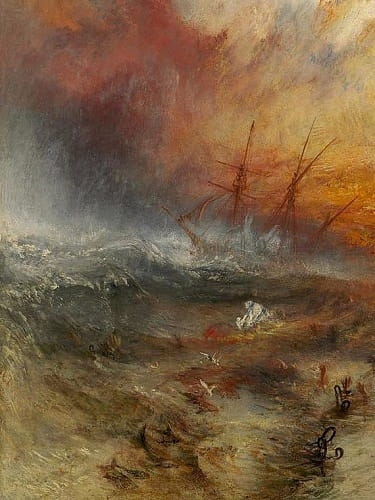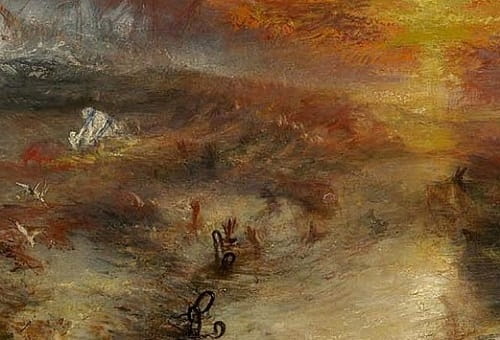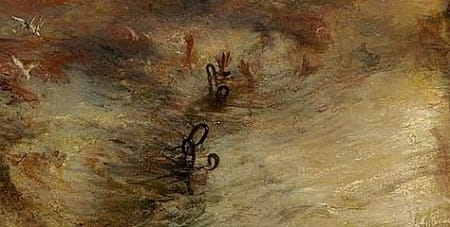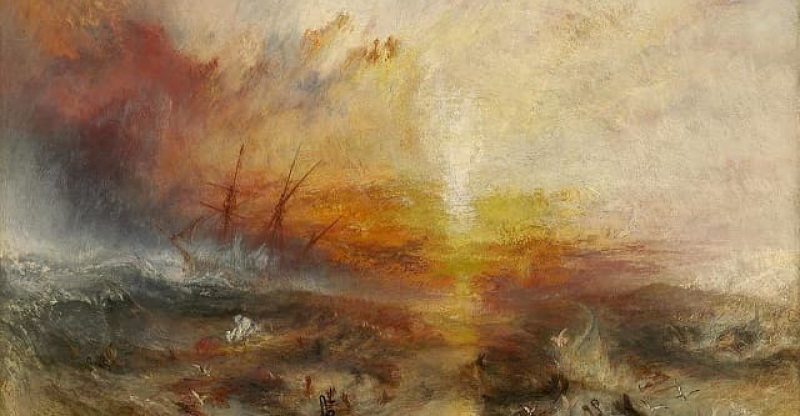Turner’s “The Slave Ship” Analysis
In the annals of art history, one painting stands out as a haunting testament to the horrors of the transatlantic slave trade – “The Slave Ship.” Created by the renowned British artist J.M.W. Turner in 1840, this powerful artwork encapsulates the human suffering and moral outrage of this dark period in history. Join us as we delve into the depths of “The Slave Ship,” exploring its symbolism, historical context, and its enduring impact on art and society.
The Slave Ship Analysis: J.M.W. Turner’s Haunting Masterpiece
Historical Background of The Slave Ship Painting
Transatlantic Slave Trade
The transatlantic slave trade was a brutal and inhumane system that involved the forced transportation of millions of African men, women, and children from their homeland to the Americas between the 15th and 19th centuries.
European powers, primarily Portugal, Spain, Britain, France, and the Netherlands, engaged in this trade to support their colonies’ labor-intensive economies, particularly in the Caribbean and the southern regions of the United States.
Africans were captured from their villages, often through violence and coercion, and then held captive in horrific conditions along the African coast. They were then crammed into overcrowded slave ships for the perilous journey across the Atlantic Ocean, known as the Middle Passage. Many enslaved Africans died during the voyage due to disease, malnutrition, and the appalling conditions on the ships.

The Slave Ship (also known as “Slavers Throwing Overboard the Dead and Dying – Typhoon Coming On”), 1840 by Joseph Mallord William Turner.
Turner’s Motivation
J.M.W. Turner was a British artist who lived during a time when the abolitionist movement in Britain was gaining momentum.
The abolitionists were a diverse group of individuals advocating for the end of the transatlantic slave trade and the liberation of enslaved people.
In 1833, the British Parliament passed the Slavery Abolition Act, which marked the beginning of the end of slavery in the British colonies. However, the trade in enslaved people continued until 1808, when Britain officially outlawed it.
The 1840 Exhibition
Turner created “The Slave Ship” in 1840 and exhibited it at the Royal Academy in London. The painting’s full title, “Slavers Throwing Overboard the Dead and Dying – Typhoon Coming On,” explicitly conveys the horrifying scene depicted in the artwork.
The exhibition of “The Slave Ship” occurred at a time when the British public was becoming increasingly aware of the brutality and inhumanity of the slave trade.
Turner’s painting was a powerful indictment of the slave trade’s atrocities, and it aimed to galvanize public opinion in favor of abolition and social justice.
Symbolism in “The Slave Ship” Painting
Turner used symbolism, vivid colors, and dramatic brushwork to evoke powerful emotions in viewers. The storm, the tossing waves, and the desperation of the enslaved Africans symbolized the moral tempest and the injustices of the trade. The painting’s emotional impact aimed to stir the conscience of viewers, prompting them to confront the moral implications of slavery and the trade that perpetuated it.
1- The Storm and Nature’s Wrath
The storm serves as a powerful symbol in the painting, representing the wrath of nature and the inevitability of justice.

The Storm and Nature’s Wrath in the Turner’s “The Slave Ship”

The Elements of Nature in the Turner’s “The Slave Ship”
The violent waves and turbulent sky mirror the tumultuous emotions of the enslaved Africans, who are at the mercy of both the elements and the cruelty of the slave trade.
The storm also symbolizes the impending doom and consequences that await those who perpetrate such heinous acts.
2- Enslaved Africans in the Waves
The bodies of the enslaved Africans, thrown overboard by the crew, represent the dehumanization and disposability of human lives during the transatlantic slave trade. Their partial submergence in the waves emphasizes their struggle for survival and the sense of powerlessness against their oppressors.

The slaves’ bodies are shown partially submerged in the raging sea – The Slave Ship Analysis.
3- The Duality of Light and Dark
J. M. W. Turner employs a stark contrast between light and dark elements in the painting. The radiant light on the right side represents hope, justice, and the divine, juxtaposed with the darkness on the left side symbolizing ignorance, cruelty, and moral corruption. This duality underlines the conflicting forces at play during the era of slavery.
4- The Sun as a Symbol of Revelation
The glowing sun breaking through the storm clouds is often interpreted as a symbol of divine revelation. It metaphorically shines a light on the hidden atrocities, exposing them to the world and calling for accountability and action.

The Sun in the Turner’s “The Slave Ship”.
“The Slave Ship” stands as a powerful testimony to the horrors of the transatlantic slave trade and the artist’s commitment to denouncing its inhumanity.
Turner’s painting played a role in raising awareness about the atrocities committed during the trade and added momentum to the growing abolitionist movement.
Today, the artwork continues to serve as a reminder of the importance of remembering and learning from history to foster a more just and compassionate society.
5- The Ship
At the center of the painting is the slave ship itself, depicted with tattered sails and damaged rigging.

The Ship in the Turner’s “The Slave Ship” – The Slave Ship Analysis.
The ship represents the vessel of suffering, a tool of oppression, and a symbol of the transatlantic slave trade. It serves as a stark reminder of the countless ships that carried enslaved Africans across the ocean under horrific conditions.
6- The Chain
The chain symbolizes the liberation of the enslaved Africans, as it appears to be broken or unshackled. This represents the hope for eventual emancipation and freedom from the chains of slavery.

The Chains in the Turner’s “The Slave Ship”.
Recommended For You – Allegories and Symbols in Paintings
7- The Birds
In the tumultuous sea, several birds can be seen. These birds, known as albatrosses, are a symbol of freedom and the desire to be free from oppression. They also signify the spirits of the deceased enslaved Africans, who have found their liberation in death.

The Birds in the Turner’s “The Slave Ship”.
8- The Fish
The fish swimming freely symbolizes the freedom that has been denied to the enslaved Africans. They serve as a reminder of the natural state of liberty that all beings should enjoy but which the enslaved Africans have been forcibly deprived of.

The Fish in the Turner’s “The Slave Ship”
By juxtaposing the free movement of fish with the captivity and suffering of the enslaved individuals, J. M. W. Turner heightens the contrast between the natural harmony of the sea and the human-inflicted chaos.
The fish, representing life, coexist with the tragic death and struggle of the enslaved Africans in the waves. This contrast further emphasizes the loss of life and human potential resulting from the slave trade.
Emotions in “The Slave Ship” Painting
Horror and Desperation
The painting evokes a profound sense of horror and desperation. The viewer is confronted with the terror experienced by the enslaved Africans, who are thrown into the unforgiving sea, facing an uncertain fate. The chaos of the storm intensifies the emotional impact, making the scene even more harrowing.
Moral Outrage
J. M. W. Turner‘s use of powerful symbolism stirs moral outrage in the viewer. The act of throwing human beings overboard represents the heartless disregard for human life and dignity. This evokes a strong emotional response, making the painting a poignant critique of the slave trade.
Empathy and Compassion
“The Slave Ship” elicits empathy and compassion for the victims of slavery. By humanizing the enslaved Africans and portraying their suffering, Turner compels viewers to connect emotionally with the subject matter, igniting a call for empathy and change.
Awe and Sublime
Despite the tragic subject matter, the painting also evokes a sense of awe and the sublime.
Turner’s mastery of depicting nature’s power and grandeur captivates the viewer, creating a profound emotional experience that transcends the mere representation of a historical event.
The Enduring Impact on Art and Society
“The Slave Ship” by J.M.W. Turner has had a profound and enduring impact on both art and society since its creation.
Impact on Art
1- Romanticism and Emotional Expression
“The Slave Ship” exemplifies the Romantic artistic movement, which emphasized emotion, individualism, and the sublime.
Turner’s innovative use of color, light, and brushwork in the painting set a new standard for emotional expression in art. His ability to evoke powerful emotions in viewers through vivid and dramatic imagery became a hallmark of Romanticism.
2- Influence on Later Artists
Turner’s unconventional approach to landscape painting in “The Slave Ship” influenced later generations of artists. His use of intense color and expressive brushstrokes laid the groundwork for Impressionism and other avant-garde movements, challenging traditional academic styles.
3- Social Commentary in Art
The painting’s subject matter and strong social commentary paved the way for artists to address pressing social and political issues through their artwork.
“The Slave Ship” demonstrated that art could serve as a powerful tool for raising awareness and advocating for change.
Impact on Society
1- Abolitionist Movement
“The Slave Ship” played a role in advancing the abolitionist cause. The painting was exhibited at a time when the abolitionist movement in Britain was gaining momentum. It served as a stark visual indictment of the horrors of the transatlantic slave trade, galvanizing public opinion in favor of abolition and social justice.
2- Public Awareness
Turner’s artwork brought the realities of the slave trade to a broader audience. Through the emotional impact of the painting, viewers were confronted with the cruelty and inhumanity of slavery, prompting them to reflect on the moral implications of such practices.
3- Historical Reflection
“The Slave Ship” continues to serve as a poignant reminder of a dark chapter in human history. It compels society to confront its past and learn from it, fostering conversations about the legacies of slavery, colonialism, and the ongoing struggle for human rights.
4- Symbol of Activism
The painting has become a symbol of activism against oppression and social injustice. It inspires individuals and groups to advocate for equal rights and to work towards a more just and compassionate world.
“The Slave Ship” by J.M.W. Turner has had a lasting impact on both the art world and society. Its emotional intensity, innovative techniques, and social commentary have influenced subsequent artistic movements and continue to inspire conversations about historical injustices and the pursuit of social progress. As a result, the painting remains an enduring symbol of the power of art to provoke thought, elicit empathy, and contribute to meaningful social transformation.
References:
- https://en.wikipedia.org/wiki/The_Slave_Ship








